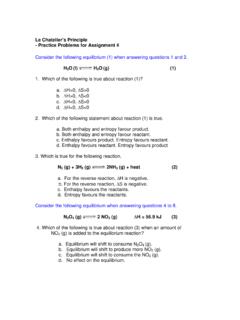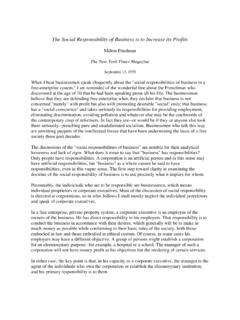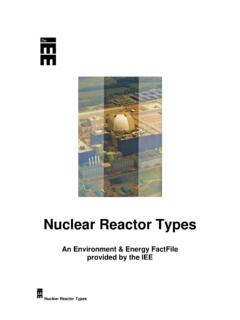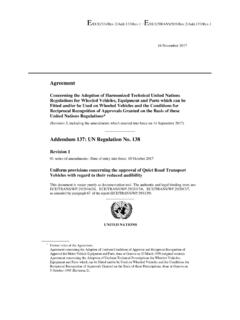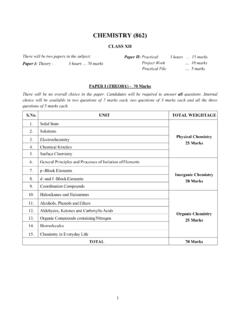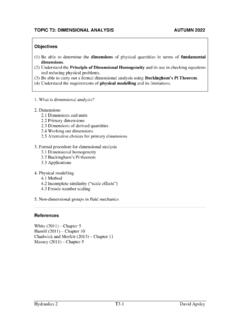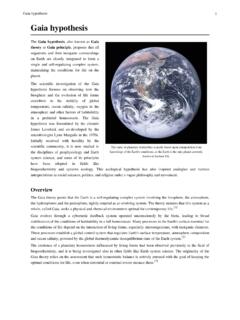Transcription of Using Manometers to Precisely Measure Pressure, Flow and …
1 Using Manometers to Precisely Measure pressure , Flow and Level Precision Measurement Since 1911 .. A1eriam Instrument llrl [ a Scott Fetzer compaii] Table of Contents Manometer principles .. :. 2 Indicating Fluids .. 5 Manometer Corrections .. 6 Digital Manometers .. 9 Applications Guide .. 12 Glossary of pressure Terms .. 16 pressure Conversions .. Inside Back Cover 1 Manometer principles The manometer, one of the earliest pressure measur-ing instruments, when used properly is very accurate. NIST recognizes the U tube manometer as a primary standard due to its inherent accuracy and simplicity of operation. The manometer has no moving parts sub-ject to wear, age, or fatigue. Manometers operate on the Hydrostatic Balance Principle: a liquid column of known height will exert a known pressure when the weight per unit volume of the liquid is known. The fundamental relationship for pressure expressed by a liquid column is p = differential pressure P 1 = pressure at the low pressure connection P2 = pressure at the high pressure connection p density of the liquid g acceleration of gravity h height of the liquid column In all forms of Manometers (U tubes, well-types, and inclines) there are two liquid surfaces.
2 pressure deter-minations are made by how the fluid moves when pressures are applied to each surface. For gauge pres-s ure, P2 is equal to zero (atmospheric reference), simplifying the equation to p= pgh U TUBE Manometers The principles of manometry are most easily demon-strated in the U tube manometer shown in Figure l. It is simply a glass tube bent to form the letter U and partially fi lled with some liquid. With both legs of the instrument open to atmosphere or subjected to the same pressure , the liquid maintains exactly the same level or a zero reference. As illustrated in Figure 2, if a pressure is applied to the left side of the instrument, the fluid recedes in the left leg and raises in the right leg. The fluid moves until the unit weight of the fluid as indicated by H exactly balances the pressure . This is known as hydrostatic balance. The height of fluid from one surface to the other is the actual height of fluid opposing the pressure .
3 The pressure is always the height of fluid from one surface to the other regardless of the shape or Size of the tubes, as illustrated in Figure 3. The left-hand 2 3 2 1 0 1 2 3 Figure 1 manometer has a uniform tube, the center one has an enlarged leg and the right-hand one has a irregular leg. Manometers in Figure 3 are open to atmosphere on both legs so the indicating fluid level in both legs is the same. Imposing an identical pressure on the left leg of each manometer, as shown in Figure 4, causes the fluid level in each manometer to change. Because of the variations in volume of the manometer legs, the distances moved by the fluid columns are different. However, the total distance between the fluid levels, H, remains identical in the three Manometers . 3 2 0 I H _j_ 2 3 Figure 2 Figure 3 H L Figure 4 WELL TYPE Manometers The principles of manometry have been discussed Using the U tube manometer as an example.
4 How-ever, the manometer has been arranged in other forms to provide greater convenience a nd to meet varying service requirements. The well type manometer is one of these variations. As illustrated in Figure 5, the cross-sectional area of one leg of the manometer is many times larger than the area of the other leg. The larger area leg is called the well. As pressure is applied to the larger leg, the fluid moves down a minuscule amount compared to the increase in height of the small leg. This des1gn results m an ideal arrangement whereby you read only one convenient scale adjacent to a smgle indicating tube rather than the dual scale in the U tube. The true pressure reading follows the principles previ-ously outlined and is measured by the difference between the nuid surfaces H. As pressure is applied 3 at P there must be some drop in the well level D.
5 This is readily compensated for by spacing the scale graduations in the exact amount required to correct for this well drop. To insure the accuracy of this correction, the well area and internal diameter of the indi-cating tube must be carefully controlled. Thus, the well type manome-ter le nds itself to use with direct reading scales gradu-ated in units for the process or test variable involved. lt does require certain operational re-strictions not found on the U tube. A pressure higher than atmospheric is always con-nected to the well ; a pressure lower than atmospheric is al-ways connected to the top of the tube. For a differential pressure , the higher pressure is connected at the well. A raised well manometer, how-ever, allows both gauge and vacuum measurements off of the well port. Figure 5 INCLINED Manometers Many applications require accurate measurement of low pressure such as drafts and very low differentials.
6 To better handle these applications the manometer is arranged with the indicating tube inclined, as in Fig-ure 6, providing for better resolution. This arrange-ment can allow 12" of scale length to represent 1" of vertical liquid height. With scale s ubdivisions, a pressure of psi (one hundredth of an inch of water) can be read. Figure 6 ABSOLUTE Manometers In an absolute pressure manometer, the pressure being measured is compared to absolute zero pressure (a perfect vacuum) in a sealed leg above a m((rcury column, as shown in Figure 7. The term absolute zero pressure is de rived from the definition that a perfect vacuum is the complete absence of any gas. The most common form of sealed tube manometer is the con-ventional mercury barometer used to Measure atmo-spheric pressure . Mercury is the only fluid used in this application. In th is type of manometer there is only one connection from which both pressure above atmospheric and pressure below atmospheric can be meas ured.))
7 Absolute Manometers are available in well type or U tube configurations. pressure REFERENCES All types of pressure references are readily me~sured 4 Figure 7 with the manometer. Connecting one leg of a U tube to a positive pressure source and leaving the other open to atmosphere is a gauge pressure measurement. Thus gauge pressures fluctuate with changes in atmo-spheric pressure . Adding the atmospheric pressure to the indicated gauge pressure converts the reading into absolute pressure units. ff, however, our air supply line should be changed to a vacuum line, the only effect is reversed movement of the fluid. It would rise in the connected leg and recede in the open leg. This is a vacuum or negative pressure reading. Subtracting this indicated gauge pressure reading from atmo-spheric pressure converts the reading into absolute pressure units.
8 INDICATING FLUIDS By selection of an indicating fluid, the sensitivity, range, and accuracy of the manometer can be altered. Indicating fluids are available with densities from glcm3 Red Oil to glcm3 for Mercury. For an indicating fluid three times heavier than water, the pressure range would be three times greater and the resolution, one third as great. An indicating fluid with a dens ity less than water, decreases the range and increases the resolution (sensitivity). For a given instrument size, the pressure range can be expanded by us ing a fluid with higher density and reduced by us ing a fluid with lower density. Meriam has stan-dard indicating fluids with properti es as described in the adj acent c hart of manometer indicating fluids. Indicating Fluids 1 000 GREEN CONCENTRATE A specially prepared concentrate which, when mixed with distilled water, makes an indicating fluid of low surface tension and practically zero hysteresis.
9 This fluid keeps indicating tubes clean and is used for high precision work. Density and physical properties are identical to water. Non-corrosive to brass, glass, stainless steel, and aluminum. Specific Gravity: t .000 @ 55 F Vapor pressure : 20mm Hg@ 20 C Temperature Range: 40 to 120 F Flash Point: Non-flashing 827 RED OIL This fluid is non-corrosive and recommended for general use in Manometers , draft gauges, air flow meters, etc., where a light fluid is desirable and where extremes in temperature are not encountered. Specific Gravity: @ 60 F Vapor pressure : lmm Hg@ 20 C Temperature Range: 40 to 120 F Flash Point: 142 F I 00 RED UNITY OIL A non-corrosive oil mixture. Prepared for general use where a fluid near the gravity of water is desired, but water itself is unsuitable. Specific Gravity: @ 73 F Temperature Range: 30 to t 00 F Vapor pressure : l mm Hg@ 20 C Flash Point: 285 F I 04 HI-V AC RED FLUJD (DIBUTYL PHTHALATE) A low vapor pressure liquid specially suited for high vacuum applications.
10 Teflon gasketing is required. Non-corrosive and insoluble in water. Specific Gravity: @ 80 F Temperature Range: 20 to 150 F Vapor pressure : lmm Hg. @ 20 C Flash Point: 340 F 175 BLUE FLUID (X-DI BROMOETHYBENZENE) A highly stable heavy liquid for use in Manometers and flow meters. Low viscosity, non-corrosive, insoluble and with a clear interface in water. Specific Gravity: @ 56 F Temperature Range: -70 F to 150 F 200 BLUE FLUID (X-DI BROMOETHYBENZENE) Meriam in acrylic incline Manometers . Specific Gravity: @ -17 F Temperature Range: -70 F to 150 F Vapor pressure : Hg@ 20 C Flash Point: Non-flashing Same as 175 Blue fluid. This fluid is normally used by Vapor pressure : Hg@ 20 C Flash Point: Non-flashing 295 NO. 3 RED FLUID (ACETYLENE TETRABROMlDE) A heavy bromide. Non-toxic, but all parts in contact with fluid must be of brass, glass, or stainless steel.



